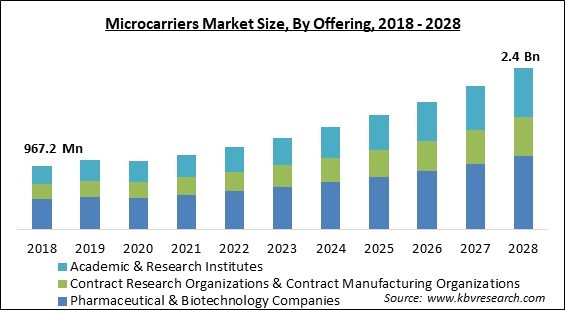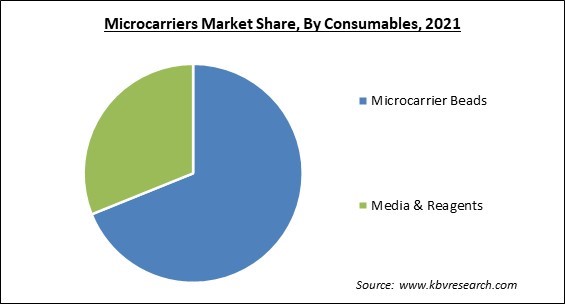The Global Microcarriers Market size is expected to reach $2.4 billion by 2028, rising at a market growth of 11.9% CAGR during the forecast period.
In bioreactors, microcarriers are the support matrix that promotes the development of adherent cells. The expansion capacity can be boosted many times more by cultivating cells on the surface of spherical microcarriers rather than a flat surface since each particle carries hundreds of cells. It offers a simple method for expanding culture systems for use in research or industrial manufacturing of cell- or protein-based therapeutics.

Cell culture is essential to biomanufacturing and medical research. Adherent cells are often cultivated in 2D on the surfaces of tissue culture plastics such flasks and well plates since they must be attached to a surface in order to live. Since these surfaces are biocompatible, cell populations could quickly grow on them. Additionally, these techniques are typically adequate for the great majority of research labs that only need to use a small number of cells.
However, for a number of established and new applications, cells need to be considerably increased. The amount of surface area that typical tissue culture polymers can give is a constraint in these circumstances. This is even before considering the handling times and throwaway expenses required for huge arrays of tissue culture flasks. The most popular method for increasing adherent cell output is to cultivate adherent cells on tiny spherical beads known as microcarriers in a stirred bioreactor.
The restrictions of surface area are solved by microcarriers, which typically have a diameter of roughly 100 m and provide a second dimension for cell expansion. The market for microcarrier-based biomanufacturing has grown significantly and now spans all production sizes. Lab-sized bioreactors with a few liters of capacity to factory-sized bioreactors with hundreds or thousands of liters are all available and can use microcarriers.
Both the amount of funds available and the need for cell culture supplies, particularly microcarrier products, are anticipated to rise as a result of the expansion in research scale. Patients are being treated symptomatically in the absence of any licensed vaccinations or antiviral medications for COVID-19. Various vaccines are under development and a few are ready to be marketed. The ability of the generated antibodies to neutralize the target virus is evaluated for both therapeutic and vaccination purposes. The demand for items in the microcarrier market has expanded since cell culture is essential to the development and production of pharmaceuticals.
The threat of new virus breakouts has grown as a result of population growth, climate change, and more animal-human contact. Examples of unforeseen and recurrent events that place a huge economic and societal burden include influenza and COVID-19. A large number of deaths across the globe due to COVID-19 have been reported by the WHO. Worldwide demand for vaccines is anticipated to be fueled by the rising prevalence of infectious illnesses and the rising risk of pandemics.
Worldwide demand for monoclonal antibodies is rising as tailored treatment options for conditions including cancer and autoimmune & inflammatory disorders become more and more common. The demand for mAbs is significant since antibodies are used in high concentrations. The use of in vitro recombinant-based technology is the preferred way of producing monoclonal antibodies. Due to the intrinsic intricacy of their post-translational modifications, antibodies are primarily generated in mammalian systems out of all potential recombinant expression methods.
Intensive research and development is put into developing novel treatments including gene and stem cell therapies. For reliable results, the tools, media, reagents, and other products used in research must be of the highest calibre. The price of cell biology research has significantly increased as a result of the growing necessity to uphold high standards (by using of high-grade products) and adhere to regulations established by regulatory organizations.
Based on consumables, the microcarriers market is segmented into media & reagents and microcarrier beads. In 2021, the microcarrier beads segment dominated the microcarriers market with the maximum revenue share. This is result of the constant utilization microcarrier beads in cell culture. The considerable market growth is related to increased cell biology research, rising regenerative medicine and biopharmaceutical demand, and the availability of numerous microcarrier beads that may be used for various applications.

On the basis of application, the microcarriers market is fragmented into biopharmaceutical production, and regenerative medicine. In 2021, the biopharmaceutical production segment witnessed the largest revenue share in the microcarriers market. The growing demand for generating safe & effective medications or treatments, coupled with the rising frequency of infectious diseases and genetic abnormalities, are the primary drivers behind this segment's domination.
By end-user, the microcarriers market is divided into pharmaceutical & biotechnology companies, contract research organizations & contract manufacturing organizations and academic & research institutes. In 2021, the contract research organizations & contract manufacturing organizations segment recorded a substantial revenue share in the microcarriers market. The use of microcarriers during cell culture will rise due to ongoing research advancements, academic institute collaborations, and outsourcing to CROs and CMOs for quicker market launch.
| Report Attribute | Details |
|---|---|
| Market size value in 2021 | USD 1.1 Billion |
| Market size forecast in 2028 | USD 2.4 Billion |
| Base Year | 2021 |
| Historical Period | 2018 to 2020 |
| Forecast Period | 2022 to 2028 |
| Revenue Growth Rate | CAGR of 11.9% from 2022 to 2028 |
| Number of Pages | 290 |
| Number of Tables | 519 |
| Report coverage | Market Trends, Revenue Estimation and Forecast, Segmentation Analysis, Regional and Country Breakdown, Companies Strategic Developments, Company Profiling |
| Segments covered | Consumables, End-user, Application, Region |
| Country scope | US, Canada, Mexico, Germany, UK, France, Russia, Spain, Italy, China, Japan, India, South Korea, Singapore, Malaysia, Brazil, Argentina, UAE, Saudi Arabia, South Africa, Nigeria |
| Growth Drivers |
|
| Restraints |
|
Region wise, the microcarriers market is analyzed across North America, Europe, Asia Pacific and LAMEA. In 2021, the North America region led the microcarriers market by generating the highest revenue share. Growing knowledge of personalized medications, improved healthcare infrastructure and reimbursement models, the existence of significant market participants, and intense R&D activities have all contributed to an increase in the incidence of chronic and infectious diseases as well as infectious diseases in general.
Free Valuable Insights: Global Microcarriers Market size to reach USD 2.4 Billion by 2028
The market research report covers the analysis of key stake holders of the market. Key companies profiled in the report include Thermo Fisher Scientific, Inc., Merck Group, Sartorius Stedim Biotech S.A. (Sartorius AG), Corning Incorporated, Bio-Rad Laboratories, Inc., Danaher Corporation, Eppendorf SE, HiMedia Laboratories Pvt. Ltd., and denovoMATRIX GmbH.
By Consumables
By End User
By Application
By Geography
The global Microcarriers Market size is expected to reach $2.4 billion by 2028.
Growing Need For Cell-Based Vaccines are driving the market in coming years, however, Cell Biology Research Is Expensive restraints the growth of the market.
Thermo Fisher Scientific, Inc., Merck Group, Sartorius Stedim Biotech S.A. (Sartorius AG), Corning Incorporated, Bio-Rad Laboratories, Inc., Danaher Corporation, Eppendorf SE, HiMedia Laboratories Pvt. Ltd., and denovoMATRIX GmbH.
The Pharmaceutical & Biotechnology Companies segment acquired maximum revenue share in the Global Microcarriers Market by End-user in 2021 thereby, achieving a market value of $1.1 billion by 2028.
The North America market dominated the Global Microcarriers Market by Region in 2021, and would continue to be a dominant market till 2028; thereby, achieving a market value of $902.2 million by 2028.
Our team of dedicated experts can provide you with attractive expansion opportunities for your business.

